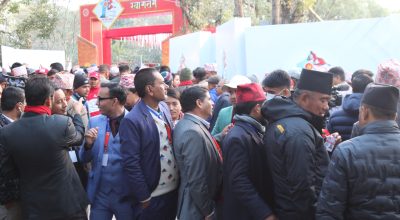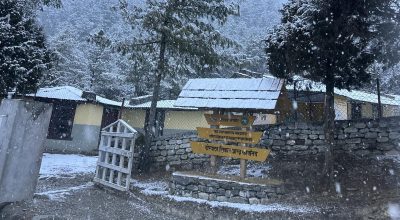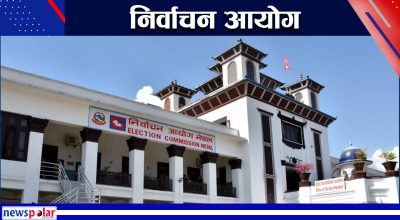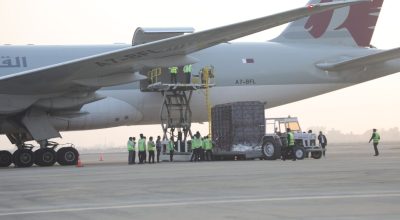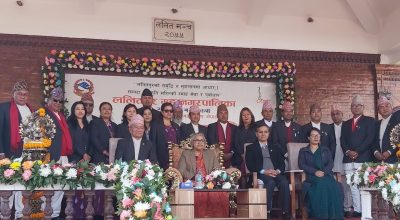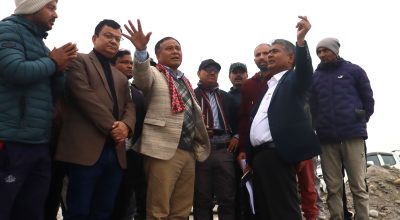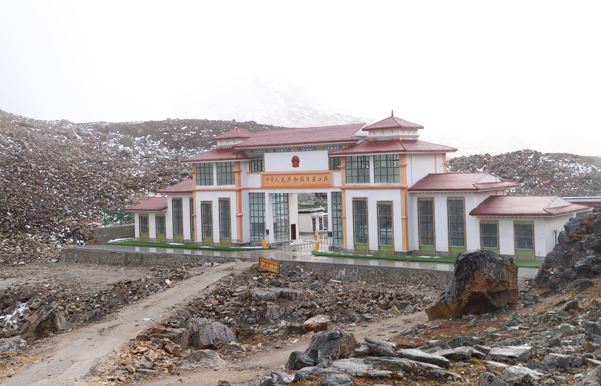
Dil Kumar Limbu
Phungling, Aug 27: The Tiptala transit at Olangchung Gola in Taplejung district has remained closed for the past four years affecting the local people in many ways ranging from halting the trade between the local people and neighbouring China and limiting their mobility.
The border crossing was closed to stop the spread of COVID-19 following the request of the Government of China shortly after Chinese workers returned home from road construction on the Nepal side, it has been said. For this, the Riu administration in Nepal was requested to close the transit point citing the risk of the spread of the virus in China through the open border.
Residents of bordering Yanga, Thudam, Olangchung Gola and Topkegola are dependent on the Chinese market for their essentials as Phungling, the district headquarters, is not accessible due to flooding and landslides during rainy season. Ninety percent of the people of Olangchung Gola in Phaktanglung-7 and Yanga and Ghunsa depend on the Chinese market for their daily necessities, said a local resident Chheten Tanshi Sherpa.
“Due to the closure of the transit for a long time, food and other essentials have stopped being supplied from China. From salt for yak and other essentials, we are not being able to bring essential commodities,” he said.
Following the closure of the crossing, the trade with China has come to a halt, said Chheten Walung, the ward chair of Phaktanglung Rural Municipality-7. At an altitude of 3,200 metres above sea level, the main business of the community of the Olangchung Gola area is trade and animal husbandry, and at an elevation of 4,200 metres above sea level, the community of Yanga was dependent on the Chinese market for their daily necessities.
As a result of the closure of the crossing for a long time, they are transporting food items from Phungling, said Jiten Chemjong, the assistant programme coordinator for the Kanchenjunga Conservation Area Management Council.
“Since the past, the Yanga community had been depending on the Chinese market. As the border was closed for a long time, they have started relying on the Nepali market,” he said. The closure of the crossing has created economic crisis for the locals, he said. According to Tenzing Walung, the ward office assistant of Phaktaglung-7, yak, cattle, animals, dairy products and carpets produced in the Nepali villages are sold in various markets of China. “The border has been shut for the past four years. Trade with China has been halted. Without the operation of business, income sources have drastically decreased,” he said.
Since the livestock business and animal products did not find a market, the traders are suffering financial crisis, he added.
The people of Olangchung Gola had been earning a good income by selling carpets in the Chinese market. But their carpets have been piled up at home for the past four years, said a local resident Lama Bhujung Sherpa. “There are 50 carpets piled up in my house. Selling carpets in the Phungling bazaar fetches low price. So I have kept them at home.”
Many villagers were forced to bring the produced carpets to Phungling and sell them at a lower price than the cost of production, he said.
Similarly, Chiraito (a medicinal herb) produced in various places of Ilam, Panchthar, Tehrathum and Taplejung districts to be transported to China through the Olangchung Gola. But since the border was closed for a long time, the traders had to transport it to Sikkim of India again through Phungling, incurring a loss in the transportation, said a local entrepreneur Dawachungdak Sherpa.
This disappointed the Chiraito farmers of Taplejung, Panchthar, Ilam and Tehrathum districts, said Man Kumar Rai, a local farmer of Yamphudin in Sirijanga Rural Municipality. “In the past, traders used to visit home looking for Chiraito but nowadays, no traders are found talking about it,” he said.
After Chiraito has stopped being supplied to China, the farmers have left the medicinal herb cultivation, said Raj Kumar Rai, a farmer of Phaktanglung-6. It cost Rs 100 per kg rice to transport a 50 kg sack of rice from Phungling to Olangchung Gola, which means one sack of 50 kg rice costs Rs 5,000 in total, said the ward chair of Phaktanglung-7 Walung. It takes one day to deliver goods to Lelep from Phungling on a vehicle. From Lelep, goods are supplied through mule or people to Olangchung Gola, Yanga, Phale and Ghunsa at an elevation of 3,200 to 4,500 metres above sea level, he said. The cost of transportation is three times more than the value of the goods, he said.
Until the crossing was closed, Chinese vehicles used to transport goods from China to the Tiptala border and from there to their homes on their own yaks, he said. “The transportation cost is very low in transporting goods from China. But it costs three times more than the purchase price in bringing goods from Phungling,” he said.
Kande Gyabu Sherpa of Yanga had 32 yaks two years ago but now the number has increased to 64. He could not sell his yaks in the Chinese market due to the closure of the border, he said.
“It has been four years since the yaks have not been sold. Yaks and their claves have not been sold since China shut the border due to COVID-19.”
The community of the Himalayan region are depending on yak rearing for their livelihoods. But the local people are finding it hard to run daily chores due to the lack of the export of yaks to China, said the local people.
Phincho Sherpa has not sold a yak from his yak shed for the past four years. The number of his yaks has increased from 25 four years ago to 60 now. Nepalese yaks, their calves, dairy products like ghee and churpi made from yak milk fetch good prices in the Chinese market, said Sonam Sherpa of Yanga.
A yak is sold for Rs 60,000 to Rs 150,000 in the Chinese market, he said. Similarly, one kg yak ghee and churpi are sold for Rs 1,200 each. There are over 2,000 yaks being reared in 35 yak sheds in Tokpekola area, said Dandu Lama, vice chair of Mikkakhola Rural Municipality.
People of seven of nine local levels of the district have been rearing yaks being encouraged by a good income from their export to China, said Pema Sherpa of Ghunsa.
Asked when the situation will ease, Walung, the ward chair of Phaktanglung Rural Municipality-7 said the Tiptala and Tiptala Bhanjyang transits would resume in one month. The news has sent a wave of happiness to the local people. “Everything will be okay once the transit opens. It will facilitate for all,” said Donga Sherpa of Olangchung Gola.
Chief District Officer Goma Devi Chemjong said the process of opening the crossing has begun.
On 5 May, 2023, a virtual meeting was held between the representatives of Dinggye County in the Tibetan Autonomous Region, China and Taplejung district regarding the opening of the border. Earlier, the ward office, Olangchung Gola, Phaktanglung Rural Municipality and the District Administration Office, Taplejung had repeatedly urged the Ministry of Home Affairs and the Ministry of Foreign Affairs to coordinate the opening of the border. According to the ward chair Walung, the Chinese officials said they would open the border allowing people’s mobility only from Tiptala Bhanjyang. Earlier, there was a mobility of people also from the Ghangla transit.
Especially, the residents of Yanga used to go to Riu through the Ghangla border. The residents of the bordering area are allowed to go to only Riu, 25 km away from the border. Tibet has now established a trading centre in Ghumti, around 35 km away from Riu, targeting Taplejung and Sankhuwasabha in Nepal. The settlement in Olangchung Gola is 24 km away from the border. It takes three days by foot to reach Riu from the settlements in Yangma near the border. But it takes one day from Olangchung Gola. RSS





